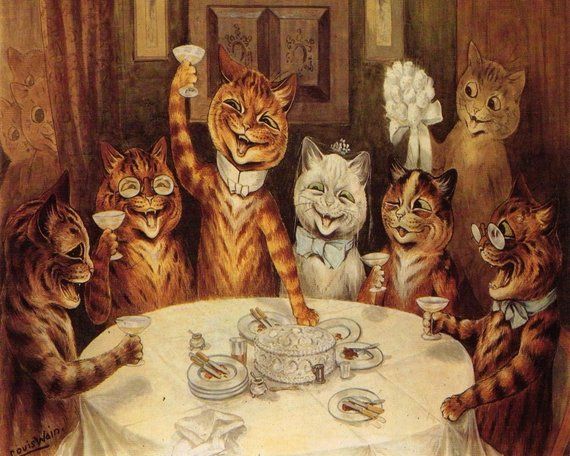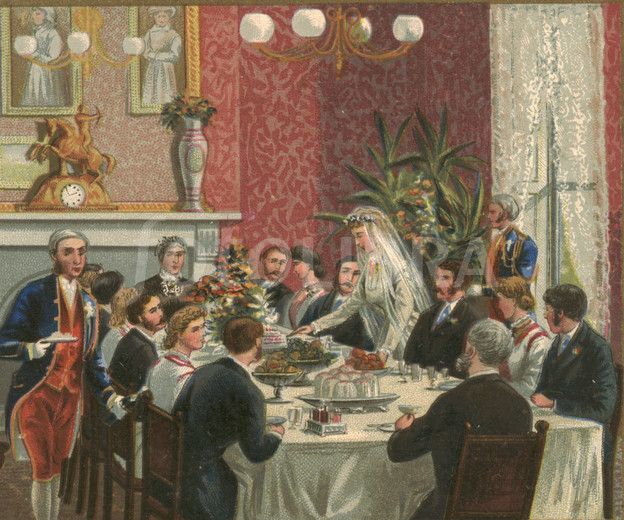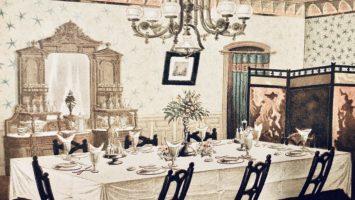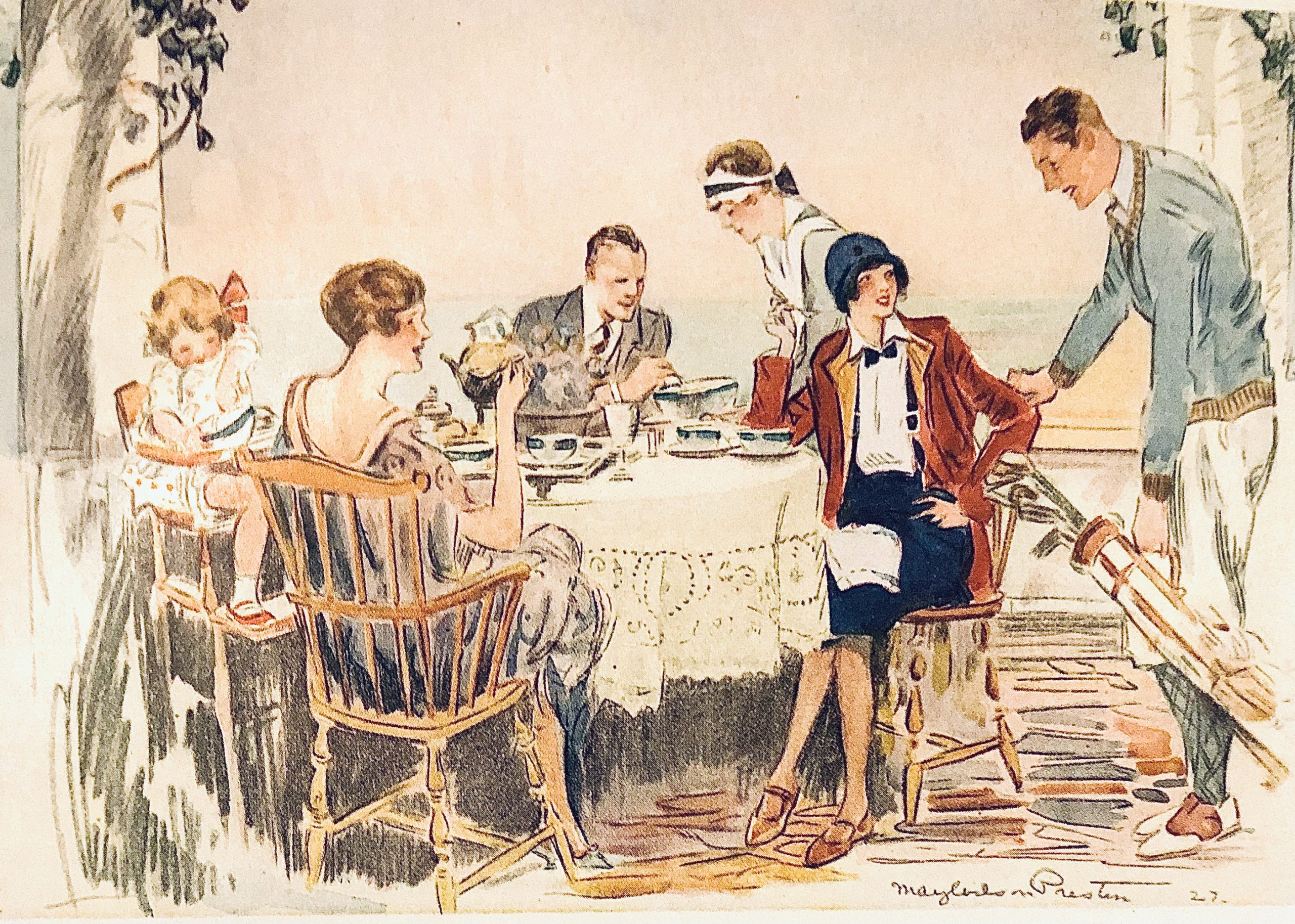The Wedding Breakfast was common in Western countries well into the twentieth century. Now, let me caveat this by saying that when one is discussing a wedding breakfast, one is speaking of the tradition that is tied historically to a Christian tradition. I hope to cover many religious traditions for weddings, (and holidays) in future posts, if you know of any good historical etiquette books that cover any of these topics please let me know!
I also want to mention that people celebrated weddings with a variety of meals there are wedding menus for dinner that I’ve found as far back as the 15th century. The wedding breakfast is only one type of celebratory meal, though likely the most common. The is just a small historical preamble before we get to the party that would be called the “wedding breakfast”.
The story goes that couples used to marry at a Eucharistic Mass, and since people were supposed to fast before taking communion, the taking of the wine and wafer was the “wedding breakfast”. Like all unproven stories that I retell in this blog, take that with a grain of salt. I could find references to the story, but no actual letters or diaries which corroborate it.
What we do know is that couples married at mass and so it follows that an early celebratory meal would have happened afterwards for family, friends and patrons. Now, as I discussed in the blog post on breakfast, in these early days, (prior to the 17th century) for the lower classes, breakfast just meant to break ones fast after sleeping and going to morning mass, but the meal itself didn’t necessarily have specialized foods or a specific etiquette. Which means it’s likely that the wedding meal was special, but might have the same types of dishes one would see at dinner or be dishes made with leftovers from dinner. It wasn’t until breakfast became a specialized meal and the breakfast party came into being, that the breakfast after a wedding would finally come to resemble a formal breakfast party.
One change that made a great impact is that with more people in an urban setting attending a church, the less anyone wanted to be married at mass or during Sunday service. Churches began allowing for a Saturday wedding with friends and family. This really separated the wedding for even average people into an event they and their families threw, rather than an event their community threw for them. Wedding breakfasts at home became normalized, with all of the exclusivity that that entails.
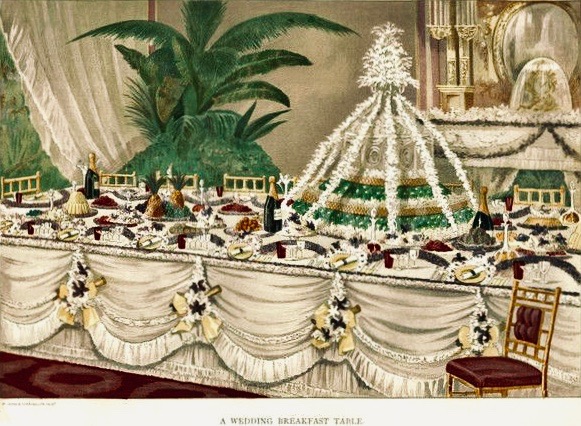
Ever the trend setter for the 19th century western world, it was Queen Victoria’s wedding breakfast that really set the rules and gave the public an ideal to emulate. Lucy Worsley recreates the Wedding Breakfast of Queen Victoria in her documentary about the marriage of Victoria and Albert and it is easy to see why Victoria’s wedding breakfast became the standard. Orderly and romantic, with the arranged seating, fancy luncheon menu and grand cake, we see the start of everything considered “tradition” at weddings today.
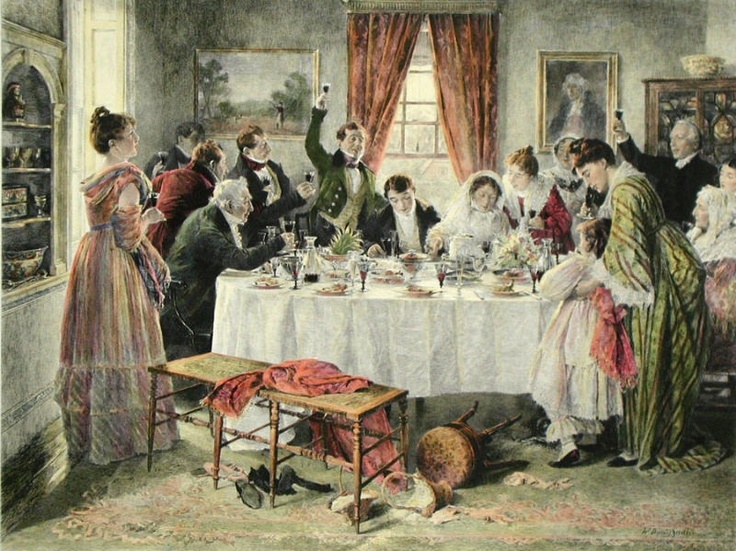
While Queen Victoria’s wedding breakfast might be considered the apex, by the end of the century, the practice was already in decline. As churches allowed for wider hours to be wed, couples began to hold weddings later in the day
“Now that the marriage hours have been extended to the afternoon, the old heavy “wedding-breakfast” will shortly be a thing of the past, and its place usurped by refreshments of a lighter and less expensive character…”
Five O’Clock Tea by the author of “Breakfast Dishes” and “Savouries and Sweets”, (1890)
The tradition of the church wedding continued well into the mid-twentieth century, though weddings at hotels and country clubs had begun to grow in popularity. By the 1920’s, iconoclast young brides were balking at the wedding breakfast in favor of the afternoon tea reception or even the evening tea dance. In America, by the late 1930’s, middle class affluence meant that weddings became status symbols and the wedding banquet became a more popular way to celebrate in a grander style, but the wedding breakfast held on as a popular option until the late 19th century.
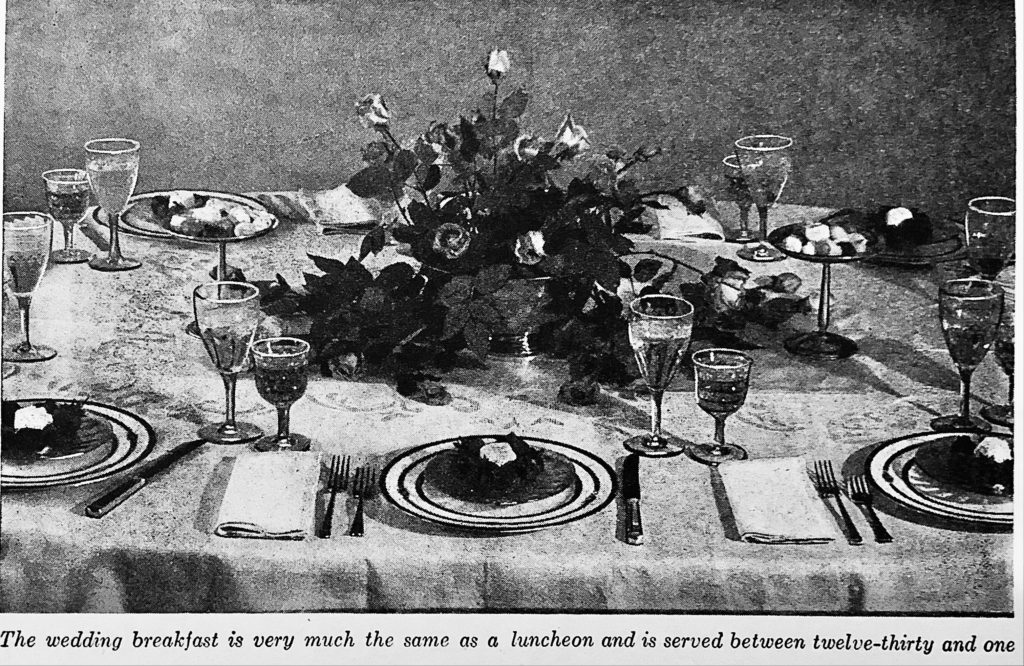
As I’ve said in earlier posts, the formal breakfast is a rare and special thing. No matter what it says above, it isn’t just a luncheon with breakfast foods and both genders. No, true formal breakfasts are their own separate animal. Yes, they resemble luncheons more than they do a family breakfast, but they are elevated to the highest degree a breakfast can achieve in design, food and dress.
Of these, the Wedding Breakfast is the most formal. Hunt breakfasts are sporty, attendees can be sweaty and attire can range depending on the sport. Ball breakfasts are the culmination of another separate event that might have a dinner and then a lighter breakfast. That is not to say that it is an afterthought, but it isn’t the high point of the event. Wedding breakfasts are a formal event held early in the day. A true sign of this, is that wedding breakfasts are the rare non-buffet and is expected to be served by staff or help.
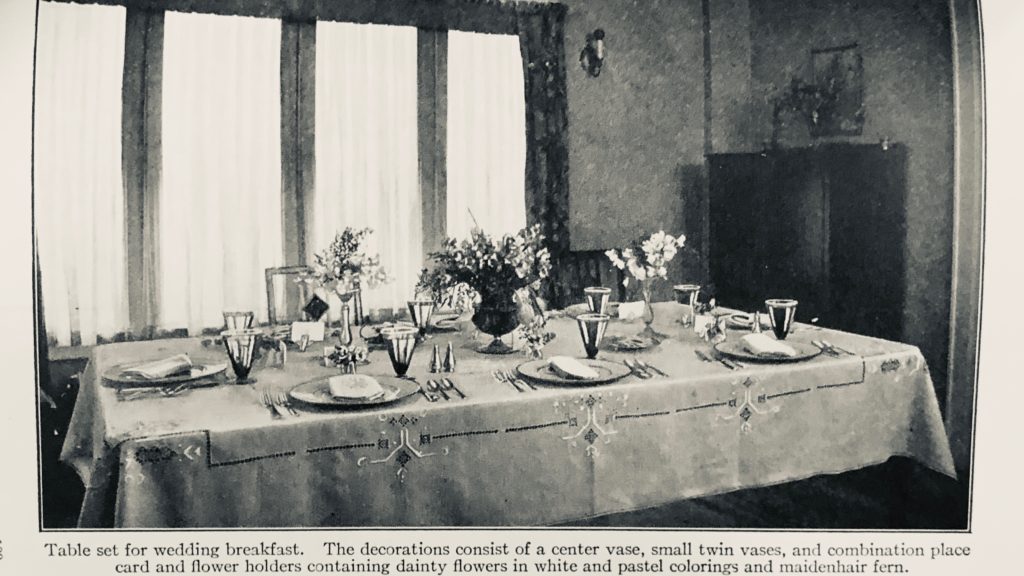
Quick Note: As always, do remember that while etiquette books may make it seem like all wedding buffets were served by staff, people do not “all” do anything. Couples held wedding breakfasts at a multitude of price points. Often these might be buffet or thrown family-style depending on the size and means of the couple. Wealthier families might have staff at home or hold their wedding breakfast at a hotel or club. When ones home was too small for the number of guests, one might hold the wedding breakfast at the church, with catering or friends volunteering to bring the food and drink.
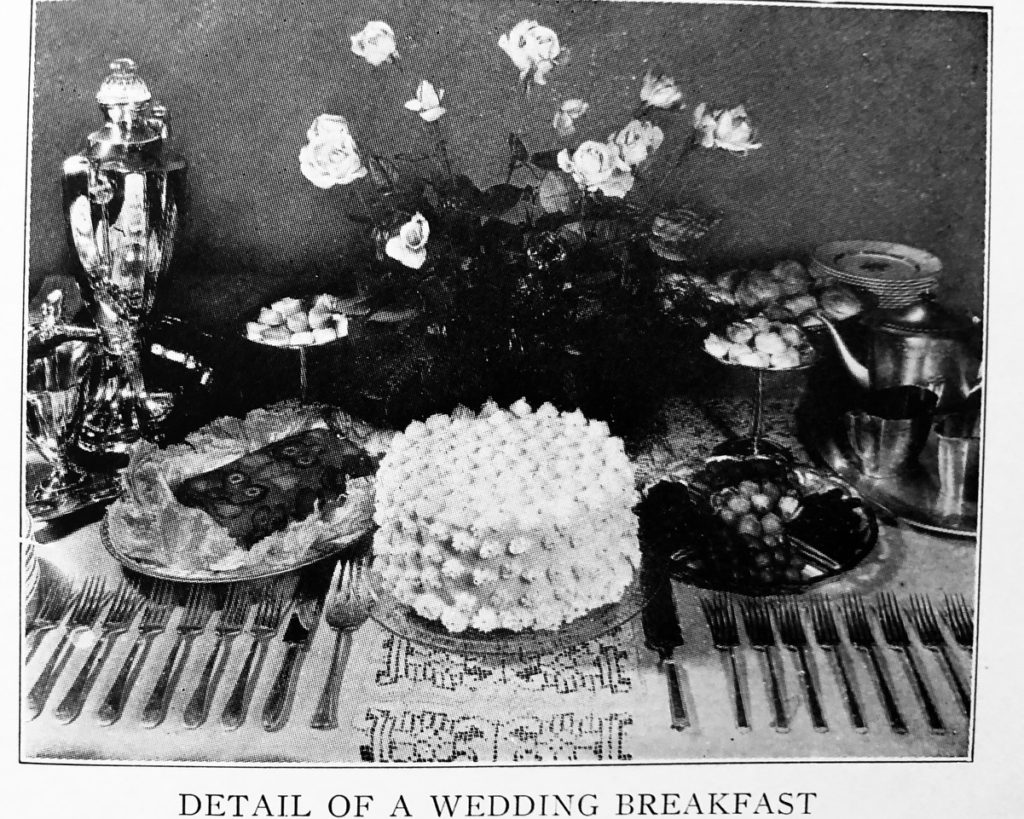
The most elite wedding breakfasts also required formal dress, with grey morning suits and top hats being expected and long formal day dresses for women. It must have been quite a sight.
So, what went into a Wedding Breakfast?
“The wedding breakfast, being a formal function, should be served in the dining-room with all the flowers and fur-belows that usually appear at weddings. The menu may be quite like the formal luncheon. If guest can be seated at the table, or at small tables, the following suggestions are appropriate. Begin with hors d’oeuvres, canapés, or fruit, follow with small fish or a fish entrée with with cucumber sandwiches, then serve a meat, chicken or sweetbread entree with buttered rolls. Coffee in teacups, with sugar and cream, may be passed after this entree is served. Salads of chicken, lobster, crab meat, or celery, and fruit, with mayonnaise and rolled-bread or toasted-cheese sandwiches. Finish with ice-creams and fancy cakes, and have the usual black fruit wedding cake in boxes for the guests when leaving. There may also be a white cake for the bride to cut. If it be a large affair, where guests are to be served while seated around the room, nothing should be served that may not be eaten with a fork or spoon. Bouillon or consommé in cups with whipped cream may be served first, or hors d’oeuvres instead of the broth; cooked lobster may follow, then sweetbreads or chicken and mushrooms creamed and in ramekin dishes, or patties, followed by the salad and ices. Champagne, possibly preceded by sherry, may be served, although this is not often done.”
The New Hostess of To-Day by Linda Hull Larned, (1931)
Today, churches have widened the days and times in which people can be wed in them, so early Saturday is no longer the only day and time for weddings. Many marry in the late afternoon or evening and have a dinner reception with dancing after. But it was really the loss of formality and the rise of the “event wedding” that spelled the death nell for the wedding breakfast. While many couples still have a morning or afternoon ceremony, the meal afterwards is usually a luncheon or buffet. There has been a movement towards the wedding brunch which would resemble the wedding breakfast, if in food only.
To show the range of wedding breakfasts, below you can see the menu for a modest at home wedding breakfast from the turn of the century. I say modest because this is a breakfast that could be held with only one servant or cook and an efficient use of a sideboard.
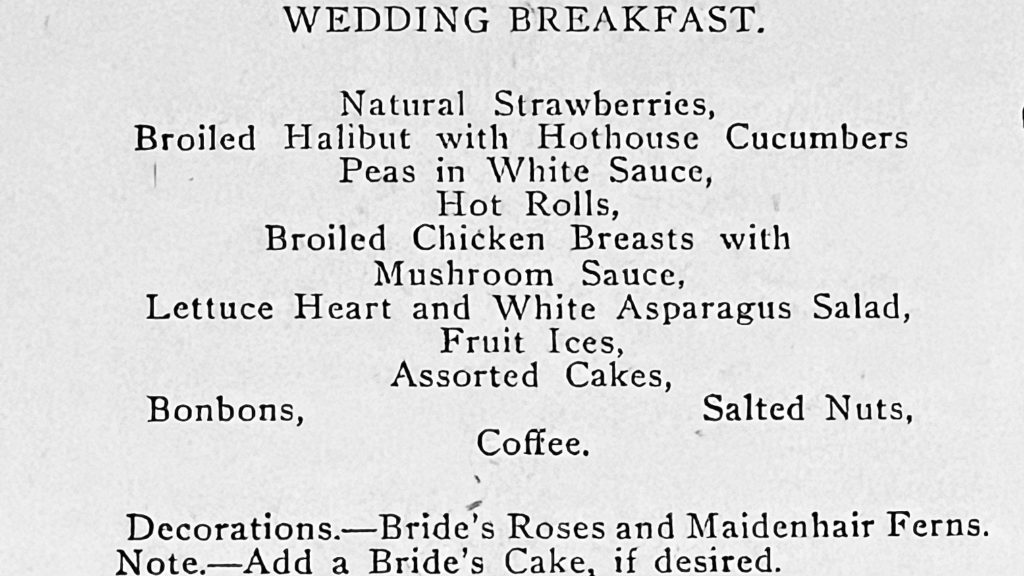
I had the usual evening wedding, but I love the idea of a wedding breakfast, how about you? Let’s hope we all get back to gatherings of loved ones soon. Much love, Cheri.
